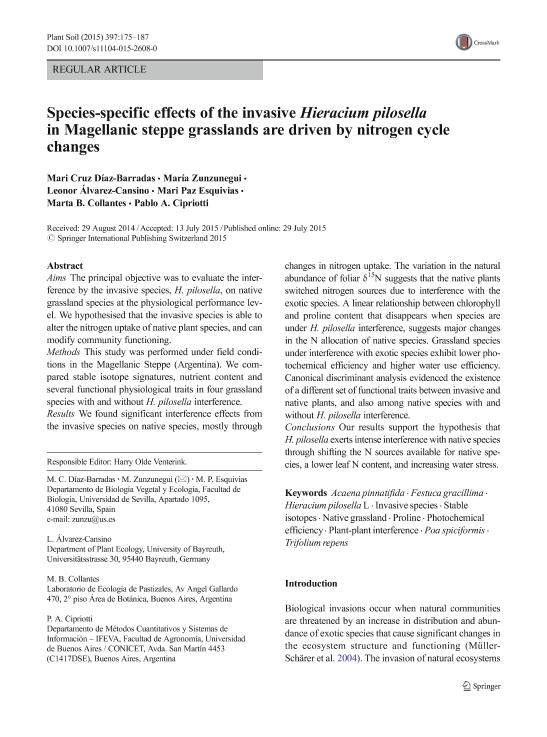Mostrar el registro sencillo del ítem
dc.contributor.author
Díaz Barradas, Mari Cruz
dc.contributor.author
Zunzunegui, María
dc.contributor.author
Álvarez Cansino, Leonor
dc.contributor.author
Esquivias, Mari Paz
dc.contributor.author
Collantes, Marta Beatriz

dc.contributor.author
Cipriotti, Pablo Ariel

dc.date.available
2017-06-05T19:48:07Z
dc.date.issued
2015-12
dc.identifier.citation
Díaz Barradas, Mari Cruz; Zunzunegui, María; Álvarez Cansino, Leonor; Esquivias, Mari Paz; Collantes, Marta Beatriz; et al.; Species-specific effects of the invasive Hieracium pilosella in Magellanic steppe grasslands are driven by nitrogen cycle changes; Springer; Plant And Soil; 397; 1; 12-2015; 175-187
dc.identifier.issn
0032-079X
dc.identifier.uri
http://hdl.handle.net/11336/17519
dc.description.abstract
Aims: The principal objective was to evaluate the interference by the invasive species, H. pilosella, on native grassland species at the physiological performance level. We hypothesised that the invasive species is able to alter the nitrogen uptake of native plant species, and can modify community functioning. Methods: This study was performed under field conditions in the Magellanic Steppe (Argentina). We compared stable isotope signatures, nutrient content and several functional physiological traits in four grassland species with and without H. pilosella interference. Results: We found significant interference effects from the invasive species on native species, mostly through changes in nitrogen uptake. The variation in the natural abundance of foliar δ15N suggests that the native plants switched nitrogen sources due to interference with the exotic species. A linear relationship between chlorophyll and proline content that disappears when species are under H. pilosella interference, suggests major changes in the N allocation of native species. Grassland species under interference with exotic species exhibit lower photochemical efficiency and higher water use efficiency. Canonical discriminant analysis evidenced the existence of a different set of functional traits between invasive and native plants, and also among native species with and without H. pilosella interference. Conclusions: Our results support the hypothesis that H. pilosella exerts intense interference with native species through shifting the N sources available for native species, a lower leaf N content, and increasing water stress.
dc.format
application/pdf
dc.language.iso
eng
dc.publisher
Springer

dc.rights
info:eu-repo/semantics/openAccess
dc.rights.uri
https://creativecommons.org/licenses/by-nc-sa/2.5/ar/
dc.subject
Acaena Pinnatifida
dc.subject
Festuca Gracillima
dc.subject
Hieracium Pilosella L
dc.subject
Invasive Species
dc.subject
Native Grassland
dc.subject
Photochemical Efficiency
dc.subject
Plant-Plant Interference
dc.subject
Poa Spiciformis
dc.subject
Proline
dc.subject
Stable Isotopes
dc.subject
Trifolium Repens
dc.subject.classification
Ecología

dc.subject.classification
Ciencias Biológicas

dc.subject.classification
CIENCIAS NATURALES Y EXACTAS

dc.title
Species-specific effects of the invasive Hieracium pilosella in Magellanic steppe grasslands are driven by nitrogen cycle changes
dc.type
info:eu-repo/semantics/article
dc.type
info:ar-repo/semantics/artículo
dc.type
info:eu-repo/semantics/publishedVersion
dc.date.updated
2017-06-02T17:32:36Z
dc.identifier.eissn
1573-5036
dc.journal.volume
397
dc.journal.number
1
dc.journal.pagination
175-187
dc.journal.pais
Suiza

dc.description.fil
Fil: Díaz Barradas, Mari Cruz. Universidad de Sevilla; España
dc.description.fil
Fil: Zunzunegui, María. Universidad de Sevilla; España
dc.description.fil
Fil: Álvarez Cansino, Leonor. University Of Bayreuth; Alemania
dc.description.fil
Fil: Esquivias, Mari Paz. Universidad de Sevilla; España
dc.description.fil
Fil: Collantes, Marta Beatriz. Consejo Nacional de Investigaciones Científicas y Técnicas. Oficina de Coordinación Administrativa Parque Centenario. Museo Argentino de Ciencias Naturales "Bernardino Rivadavia"; Argentina
dc.description.fil
Fil: Cipriotti, Pablo Ariel. Consejo Nacional de Investigaciones Científicas y Técnicas. Oficina de Coordinación Administrativa Parque Centenario. Instituto de Investigaciones Fisiológicas y Ecológicas Vinculadas a la Agricultura. Universidad de Buenos Aires. Facultad de Agronomía. Instituto de Investigaciones Fisiológicas y Ecológicas Vinculadas a la Agricultura; Argentina
dc.journal.title
Plant And Soil

dc.relation.alternativeid
info:eu-repo/semantics/altIdentifier/doi/http://dx.doi.org/10.1007/s11104-015-2608-0
dc.relation.alternativeid
info:eu-repo/semantics/altIdentifier/doi/https://link.springer.com/article/10.1007%2Fs11104-015-2608-0
Archivos asociados
